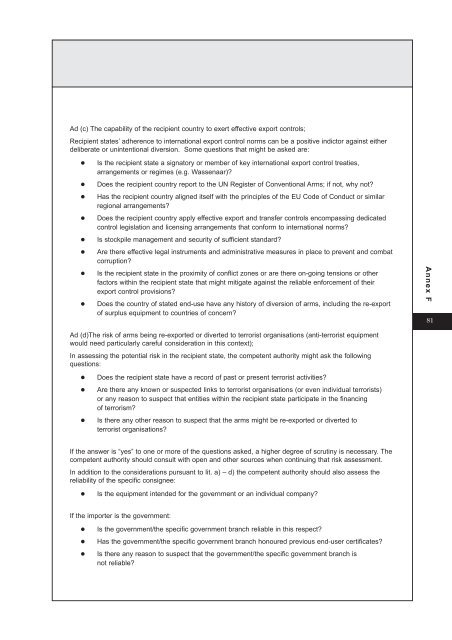Annex A - Official Documents
Annex A - Official Documents
Annex A - Official Documents
Create successful ePaper yourself
Turn your PDF publications into a flip-book with our unique Google optimized e-Paper software.
Ad (c) The capability of the recipient country to exert effective export controls;<br />
Recipient states’ adherence to international export control norms can be a positive indictor against either<br />
deliberate or unintentional diversion. Some questions that might be asked are:<br />
� Is the recipient state a signatory or member of key international export control treaties,<br />
arrangements or regimes (e.g. Wassenaar)?<br />
� Does the recipient country report to the UN Register of Conventional Arms; if not, why not?<br />
� Has the recipient country aligned itself with the principles of the EU Code of Conduct or similar<br />
regional arrangements?<br />
� Does the recipient country apply effective export and transfer controls encompassing dedicated<br />
control legislation and licensing arrangements that conform to international norms?<br />
� Is stockpile management and security of sufficient standard?<br />
� Are there effective legal instruments and administrative measures in place to prevent and combat<br />
corruption?<br />
� Is the recipient state in the proximity of conflict zones or are there on-going tensions or other<br />
factors within the recipient state that might mitigate against the reliable enforcement of their<br />
export control provisions?<br />
� Does the country of stated end-use have any history of diversion of arms, including the re-export<br />
of surplus equipment to countries of concern?<br />
Ad (d)The risk of arms being re-exported or diverted to terrorist organisations (anti-terrorist equipment<br />
would need particularly careful consideration in this context);<br />
In assessing the potential risk in the recipient state, the competent authority might ask the following<br />
questions:<br />
� Does the recipient state have a record of past or present terrorist activities?<br />
� Are there any known or suspected links to terrorist organisations (or even individual terrorists)<br />
or any reason to suspect that entities within the recipient state participate in the financing<br />
of terrorism?<br />
� Is there any other reason to suspect that the arms might be re-exported or diverted to<br />
terrorist organisations?<br />
If the answer is “yes” to one or more of the questions asked, a higher degree of scrutiny is necessary. The<br />
competent authority should consult with open and other sources when continuing that risk assessment.<br />
In addition to the considerations pursuant to lit. a) – d) the competent authority should also assess the<br />
reliability of the specific consignee:<br />
� Is the equipment intended for the government or an individual company?<br />
If the importer is the government:<br />
� Is the government/the specific government branch reliable in this respect?<br />
� Has the government/the specific government branch honoured previous end-user certificates?<br />
� Is there any reason to suspect that the government/the specific government branch is<br />
not reliable?<br />
<strong>Annex</strong> F<br />
81

















